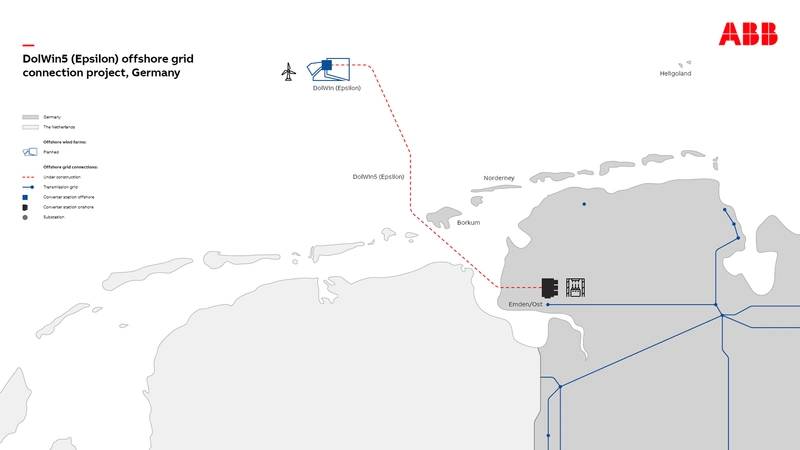

While maintaining the integrity of power supply, digitalization and the integration of data have been prioritized in the energy transition process, ensuring a robust telecommunications infrastructure is essential for operational success. A well-designed and integrated telecommunications solution is critical in driving offshore wind operations and plays an integral role in connecting hundreds of physical assets and vessels. ABB Energy industries’ Ian Holden explains.
Across the world and in many seas, new technologies are being harnessed to meet our power needs. Increasingly, renewable sources of energy, including offshore wind, are enabling a more efficient power supply. This impetus to evolve and look for new opportunities has been accelerated by the many challenges the industry has faced in recent years.
Offshore wind power has proven attractive to energy companies for many reasons; from reducing carbon emissions to utilizing existing rig infrastructure and transferable skills, the synergies between sectors make this progression a natural one. As we leverage increasing amounts of energy from wind farms, it is important to assess the integral role of seamless telecommunications.
Huge offshore areas covering tens or hundreds of square kilometers of wind turbines need high availability communications for every turbine and substation. Developments over recent years mean that wind turbines have longer blades, taller towers, lower maintenance needs, and can operate more efficiently. However, as these installations are unmanned, with increases in size and scale, full visibility and reliable telecommunications solutions from onshore facilities often require long-range connectivity.
A dependable network will enable a safer work environment for remote monitoring, inspection, and operation. The benefits of smooth and reliable telecommunications extend to maritime safety and navigation systems as well. Aeronautical safety, navigation systems, general alarm systems and vessel tracking are also supported by effective telecommunication systems. Essentially, smooth and extensive connectivity results in an improvement in the functionality and productivity of any offshore wind farm.
 Image courtesy ABB
Image courtesy ABB
Enabling Turbine Data Analysis
There are many communications solutions for wind farms. The turbine itself typically has a programmable logic controller (PLC) for control purposes and connects to the turbine assets via input/output (I/O) and industry-standard protocols.
Data is gathered in the PLC which is used for supervision, control, and asset monitoring, as is typical for all rotating or mechanical equipment and electrical systems. This PLC is a communication gateway to the turbine. The more data that can be accessed from every turbine, the more beneficial it is to the cost of operation. This data is not only for operators but for the maintenance team.
It is costly to send personnel to offshore assets. Therefore, the greater the visibility to the events and equipment condition or status from onshore, the fewer trips required for inspection. When a visit is required for maintenance or inspection purposes, the engineer is better prepared, having had access to all the instrumented asset data on the platform in advance.
Boosting Availability
As the turbines are connected to the substation via subsea cables, fiber cables laid at the same time will ensure a robust, high-performance solution is available for communications between the turbines and substation. This fiber can also be utilized to monitor the power cables for movement and hot spots. Communications availability can be further increased if fiber is run between turbines, providing alternative routes for communications traffic to the substation.
Fiber is not the only solution; radio links, including microwave, are possible with the performance being dependent on distances. Meshed networks are another option. More recently, the emergence of 5G means whole-farm coverage will be possible. This is an area where ABB is collaborating with 5G technology providers and offshore asset owners and operators.
With large distances of up to 120 km between onshore and offshore assets, operators will need seamless standard optical interfaces that don’t require boosting.
Multi-scope Lifecycle Support
As energy companies look towards increasingly unmanned operations, the need for more data and remote visibility has grown. Operators require greater closed-circuit television (CCTV) coverage, and safety systems are still required when personnel is present, including the public address and general alarm system (PAGA).
The ability to integrate electrical, control, and telecommunications solutions as a single scope for offshore wind projects is key. This not only removes the layers of interface management; it simplifies project execution and enables comprehensive integrated system testing, which in turn removes risk from the installation and commissioning phases.
Much of ABB’s historical offshore experience is carried forward to offshore wind projects, including Dogger Bank and Dolwin 5. ABB provides critical safety systems as part of the telecoms scope for both projects, and many of these systems are integrated offshore and fully accessible from onshore.
The Cyber Challenge
One of the most significant challenges within the telecoms space is cyber security and the need to reduce risk by employing a systematic approach. High availability telecommunications enable autonomous operations and allow for a more secure facility.
Supply must always adhere to any company’s own internal, customer, and national cyber security requirements. The latter is relevant to the architecture and numerous operational and safety-critical systems from multiple original equipment manufacturers (OEMs).
Technological innovation, digitization, and automation are transforming how the industry operates. As wind farms scale up offshore, increased and more advanced telecommunications are the key enabler for this evolution.